1998 CHEVROLET VENTURE weight
[x] Cancel search: weightPage 17 of 474
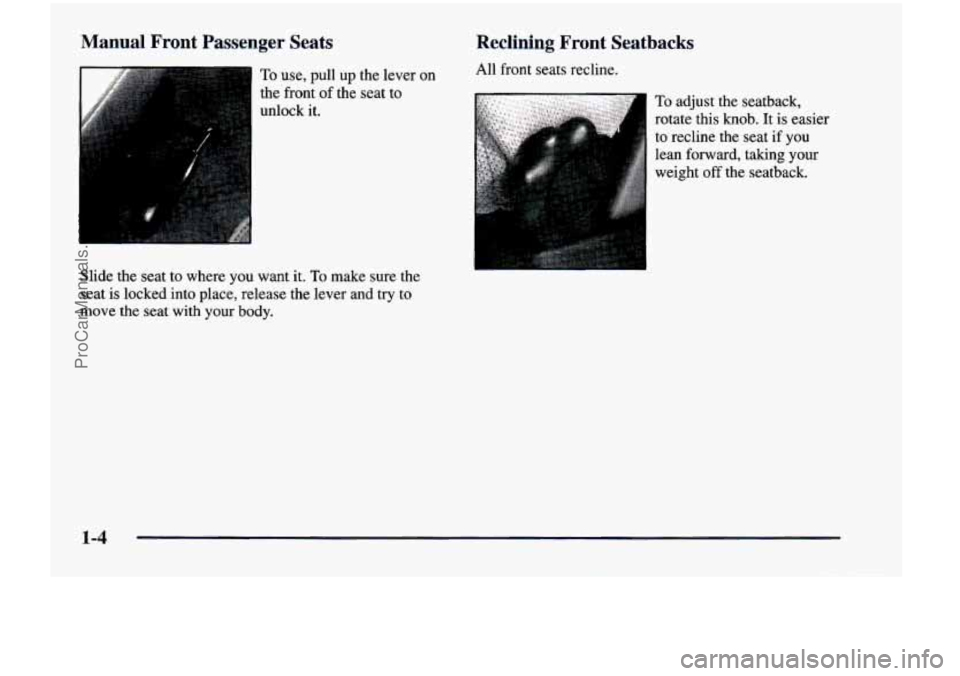
Manual Front Passenger Seats
To use, pull up the lever on
the front
of the seat to
unlock it.
Slide the seat to where you want it.
To make sure the
seat is locked into place, release the lever and try to
move the seat with your body.
Reclining Front Seatbacks
All front seats recline.
To adjust the seatback,
rotate this knob. It
is easier
to recline the seat if you
lean
forward, taking your
weight
off the seatback.
1-4
ProCarManuals.com
Page 46 of 474
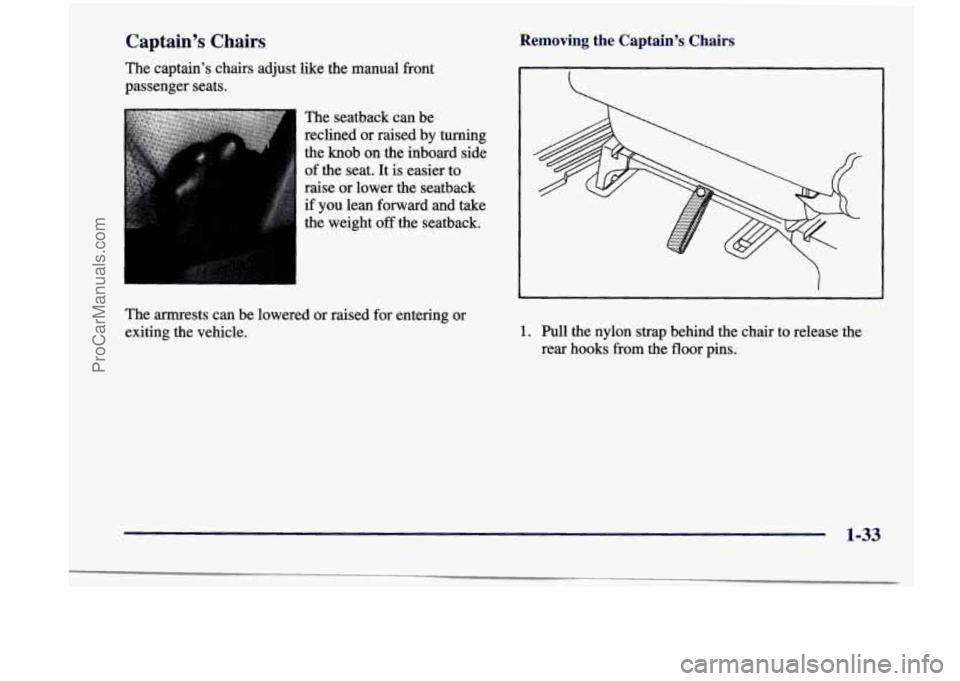
Captain’s Chairs
The captain’s chairs adjust like the manual front
passenger seats.
The seatback can be
reclined or raised by turning
the knob on the inboard side
of the seat. It is easier to
raise or lower the seatback
if you lean forward and take
the weight
off the seatback.
The armrests can be lowered or raised for entering or
exiting the vehicle.
Removing the Captain’s Chairs
I I
1
1. Pull the nylon strap behind the chair to release the
rear hooks from the floor pins.
1-33
ProCarManuals.com
Page 95 of 474
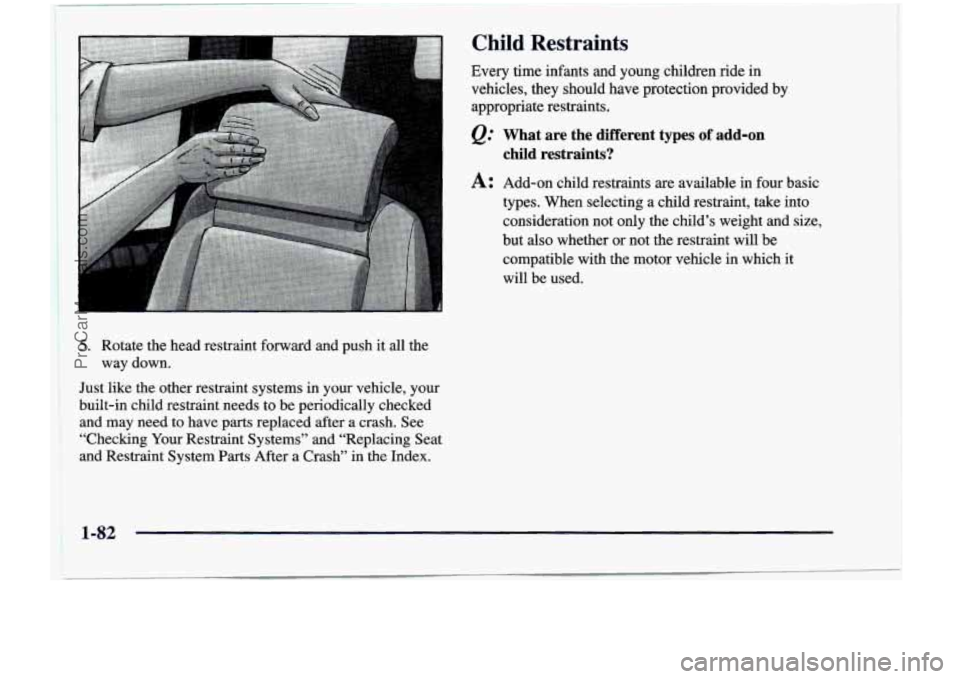
5. Rotate the head restraint forward and push it all the
way down.
Child Restraints
Every time infants and young children ride in
vehicles, they should have protection provided by
appropriate restraints.
&= What are the different types of add-on
A: Add-on child restraints are available in four basic
types. When selecting a child restraint, take into
consideration not only the child’s weight and size,
but also whether
or not the restraint will be
compatible with the motor vehicle in which it
will be used.
child restraints?
Just like the other restraint systems in your vehicle, your
built-in child restraint needs to be periodically checked
and may need
to have parts replaced after a crash. See
“Checking Your Restraint Systems” and “Replacing Seat
and Restraint System
Parts After a Crash” in the Index.
1
ProCarManuals.com
Page 154 of 474
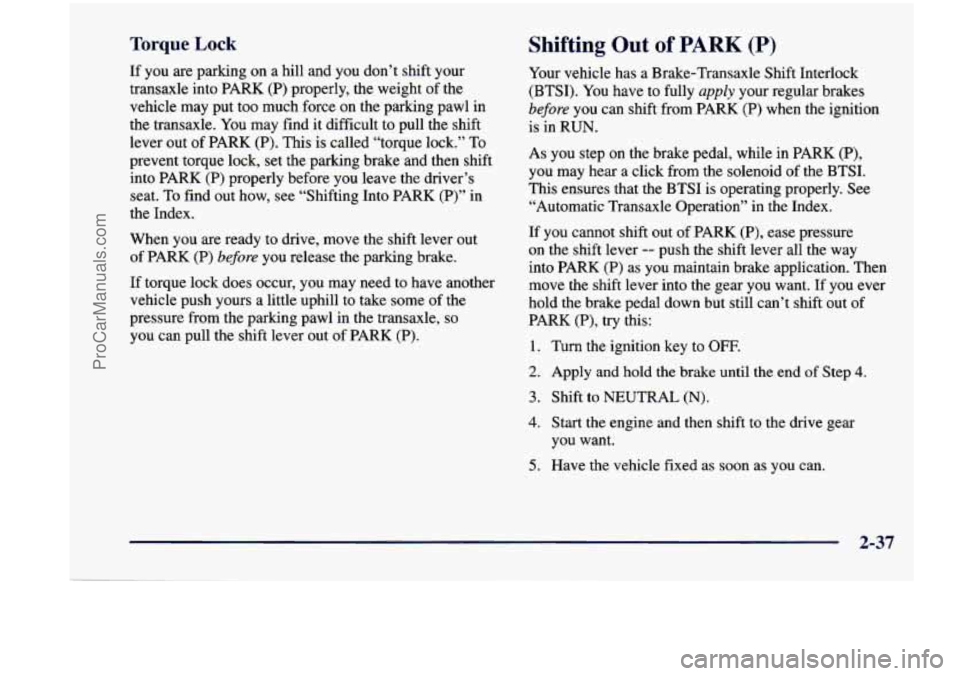
Torque Lock Shifting Out of PARK (P)
If you are parking on a hill and you don’t shift your
transaxle into PARK (P) properly, the weight of the
vehicle may put
too much force on the parking pawl in
the transaxle. You may find it difficult to pull the shift
lever out
of PARK (P). This is called “torque lock.” To
prevent torque lock, set the parking brake and then shift
into PARK
(P) properly before you leave the driver’s
seat.
To find out how, see “Shifting Into PARK (P)” in
the Index.
When you are ready to drive, move the shift lever out
of PARK
(P) before you release the parking brake.
If torque lock does occur, you may need to have another
vehicle push yours a little uphill
to take some of the
pressure
from the parking pawl in the transaxle, so
you can pull the shift lever out of PARK (P). Your
vehicle has a Brake-Transaxle Shift Interlock
(BTSI). You have to fully apply your regular brakes
before you can shift from PARK (P) when the ignition
is in
RUN.
As you step on the brake pedal, while in PARK (P),
you may hear a click from the solenoid of the BTSI.
This ensures that the BTSI is operating properly. See
“Automatic Transaxle Operation” in the Index.
If you cannot shift out
of PARK (P), ease pressure
on the shift lever
-- push the shift lever all the way
into PARK
(P) as you maintain brake application. Then
move the shift lever into the gear you want. If you ever
hold the brake pedal down but still can’t shift out of
PARK
(P), try this:
1. Turn the ignition key to OFF.
2. Apply and hold the brake until the end of Step 4.
3. Shift to NEUTRAL (N).
4. Start the engine and then shift to the drive gear
you want.
5. Have the vehicle fixed as soon as you can.
2-37
ProCarManuals.com
Page 192 of 474
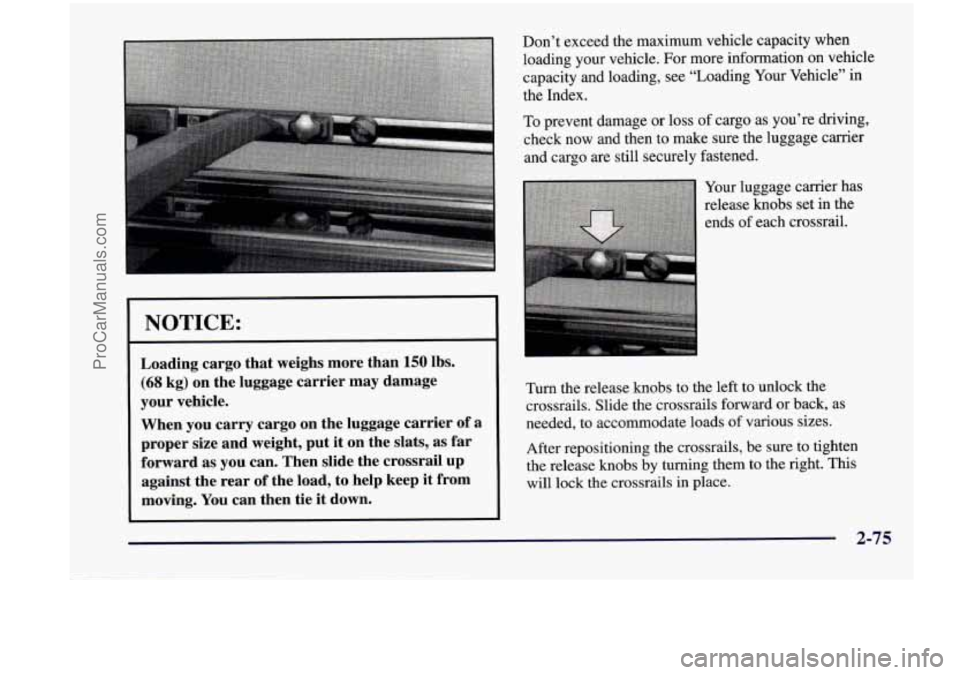
NOTICE:
Loading cargo that weighs more than 150 lbs.
(68 kg) on the luggage carrier may damage
your vehicle.
When you carry cargo
on the luggage carrier of a
proper size and weight, put it on the slats, as
far
forward as you can. Then slide the crossrail up
against the rear
of the load, to help keep it from
moving.
You can then tie it down. Don't exceed the
maximum vehicle capacity when
loading your vehicle. For more information on vehicle
capacity and loading, see "Loading Your Vehicle" in
the Index.
To prevent damage or loss of cargo as you're driving,
check now and then to make sure the luggage carrier
and cargo are still securely fastened.
Your luggage carrier has
release knobs set in the
ends of each crossrail.
Turn the release knobs to the left to unlock the
crossrails. Slide the crossrails forward or back, as
needed,
to accommodate loads of various sizes.
After repositioning the crossrails, be sure
to tighten
the release knobs by turning them to the right.
This
will lock the crossrails in place.
2-75
ProCarManuals.com
Page 256 of 474
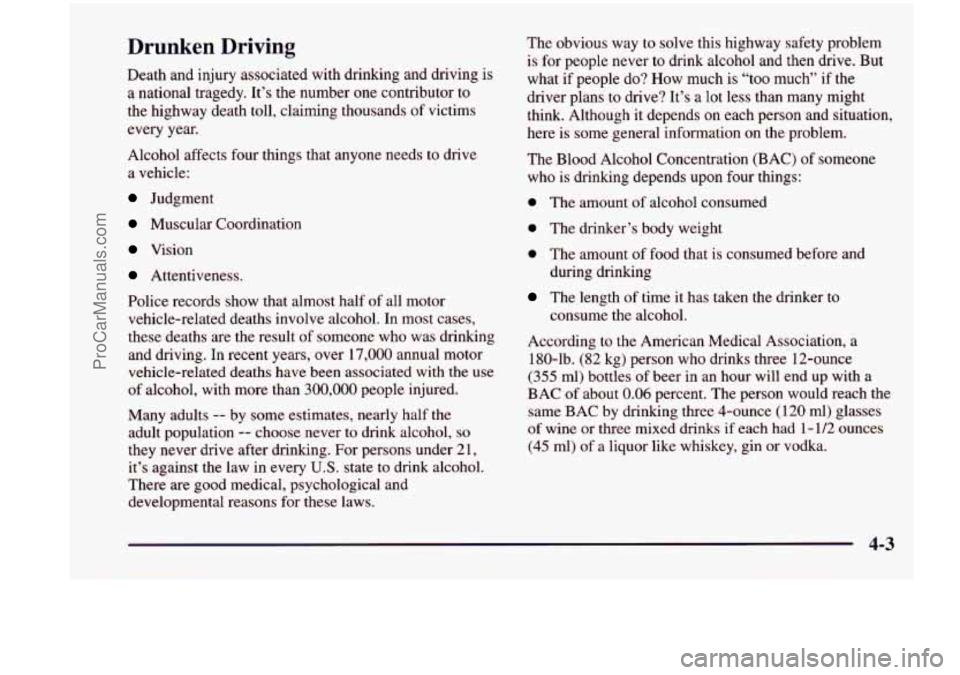
Drunken Driving
Death and injury associated with drinking and driving is
a national tragedy. It’s the number one contributor to
the highway death toll, claiming thousands of victims
every year.
Alcohol affects four things that anyone needs to drive
a vehicle:
Judgment
Muscular Coordination
Vision
Attentiveness.
Police records show that almost half of all motor
vehicle-related deaths involve alcohol. In most cases,
these deaths are the result of someone who was drinking
and driving. In recent years, over
17,000 annual motor
vehicle-related deaths have been associated with the use of alcohol, with more than
300,000 people injured.
Many adults
-- by some estimates, nearly half the
adult population
-- choose never to drink alcohol, so
they never drive after drinking. For persons under 21,
it’s against the law in every U.S. state to drink alcohol.
There are good medical, psychological and
developmental reasons for these laws. The
obvious way to solve this highway safety problem
is for people never to drink alcohol and then drive. But
what if people do? How
much is “too much” if the
driver plans to drive? It’s
a lot less than many might
think. Although it depends on each person and situation,
here is some general information on the problem.
The Blood Alcohol Concentration (BAC)
of someone
who is drinking depends upon four things:
0 The amount of alcohol consumed
0 The drinker’s body weight
0 The amount of food that is consumed before and
during drinking
The length of time it has taken the drinker to
consume the alcohol.
According to the American Medical Association, a
180-lb.
(82 kg) person who drinks three 12-ounce
(355 ml) bottles of beer in an hour will end up with a
BAC
of about 0.06 percent. The person would reach the
same BAC by drinking three 4-ounce
(120 ml) glasses
of wine or three mixed drinks if each had 1-1/2 ounces
(45
ml) of a liquor like whiskey, gin or vodka.
4-3
ProCarManuals.com
Page 257 of 474
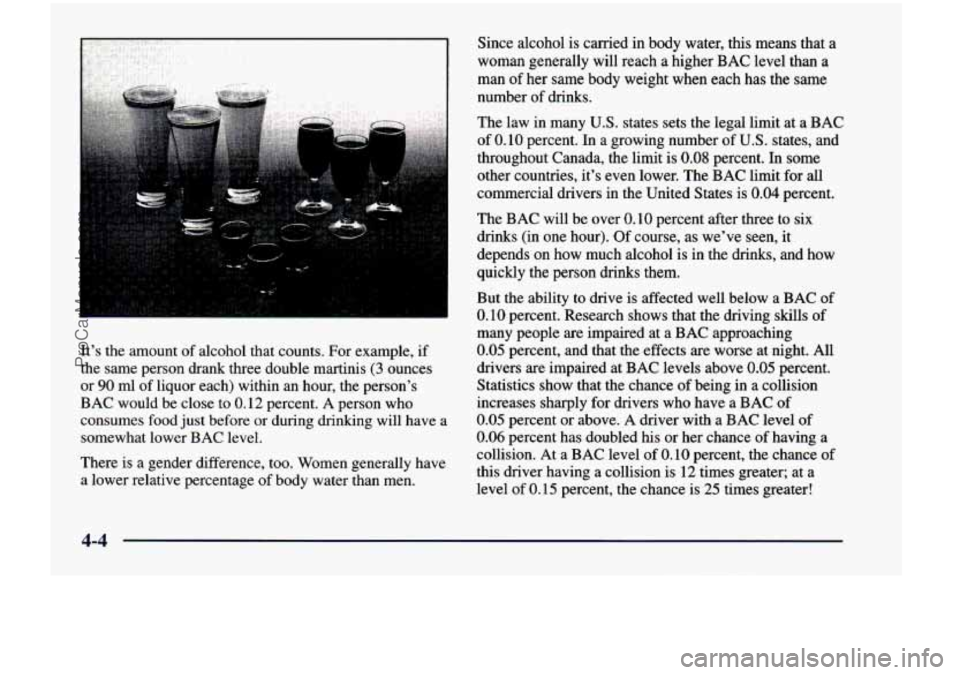
: , :.. . . .:. . .. .
It’s the amount of alcohol that counts. For example, if
the same person drank three double martinis
(3 ounces
or
90 ml of liquor each) within an hour, the person’s
BAC would be close
to 0.12 percent. A person who
consumes food just before or during drinking will have a
somewhat lower
BAC level.
There
is a gender difference, too. Women generally have
a lower relative percentage
of body water than men. Since
alcohol is carried in body water, this means that a
woman generally will reach a higher
BAC level than a
man of her same body weight when each has the
same
number of drinks.
The law in many
U.S. states sets the legal limit at a BAC
of
0.10 percent. In a growing number of U.S. states, and
throughout Canada, the limit is
0.08 percent. In some
other countries, it’s even lower. The BAC limit for all
commercial drivers in the United States is
0.04 percent.
The BAC will be over
0.10 percent after three to six
drinks (in one hour).
Of course, as we’ve seen, it
depends on how much alcohol is in the drinks, and how
quickly the person drinks them.
But the ability to drive is affected well below a BAC of
0.10 percent. Research shows that the driving skills of
many people are impaired at a BAC approaching
0.05 percent, and that the effects are worse at night. All
drivers are impaired at BAC levels above
0.05 percent.
Statistics show that the chance
of being in a collision
increases sharply for drivers who have a BAC of
0.05 percent or above. A driver with a BAC level of
0.06 percent has doubled his or her chance of having a
collision. At a BAC level of 0.10 percent, the chance of
this driver having a collision is
12 times greater; at a
level of
0.15 percent, the chance is 25 times greater!
4-4
ProCarManuals.com
Page 259 of 474
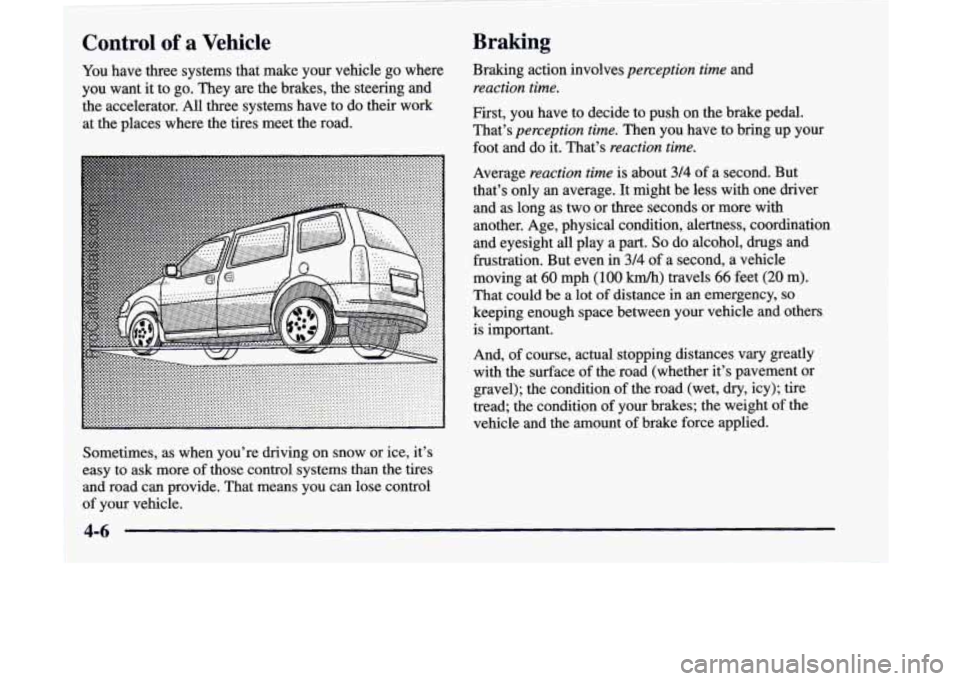
Control of a Vehicle
You have three systems that make your vehicle go where
you want
it: to go. They are the brakes, the steering and
the accelerator. All three systems have to do their work
at the places where the tires meet the road.
Sometimes,
as when you’re driving on snow or ice, it’s
easy to
ask more of those control systems than the tires
and road can provide, That means you can lose control
of
your vehicle.
Braking
Braking action involves perceprlon time and
reaction time.
First, you have to decide to push on the brake pedal.
That’s
perception time. Then you have to bring up your
foot and do it. That’s
reaction time.
Average reaction time is about 3/4 of a second. But
that’s only an average. It might be less with one driver
and
as long as two or three seconds or more with
another. Age, physical condition, alertness, coordination
and eyesight
all play a part. So do alcohol, drugs and
frustration. But even in
3/4 of a second, a vehicle
moving at
60 mph (100 km/h) travels 66 feet (20 m).
That could be a lot of distance in an emergency, so
keeping enough space between your vehicle and others
is important.
And, of course, actual stopping distances
vary greatly
with the surface
of the road (whether it’s pavement or
gravel); the condition of the road (wet, dry, icy); tire
tread; the condition
of your brakes; the weight of the
vehicle and the amount of brake force applied.
4-6
ProCarManuals.com